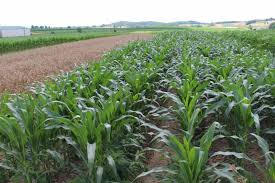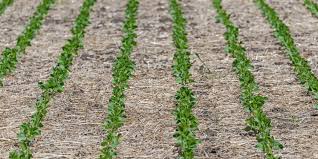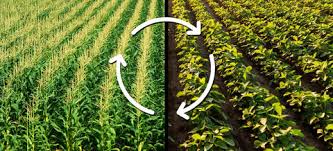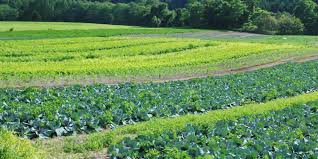Continuous cropping is an agricultural practice where the same crop is grown repeatedly on the same land season after season. This method is often chosen for its simplicity, as it allows farmers to specialize in a single crop that might be in high demand or suited to their local climate.
Crops like maize, wheat, and rice are commonly grown through continuous cropping. However, while this practice can maximize short-term yields, it has several long-term drawbacks. Continuous cropping can lead to soil degradation, nutrient depletion, and an increased risk of pests and diseases.
When the same crop is planted repeatedly, it consumes the same nutrients from the soil, which can result in reduced soil fertility over time. In addition, pests and diseases that target that particular crop tend to build up in the soil and surrounding environment, leading to more significant infestations and outbreaks. Farmers often resort to using chemical fertilizers and pesticides to address these issues, which can further impact soil health and biodiversity.
Crop rotation, on the other hand, is the practice of growing different crops in a planned sequence on the same land over several seasons. This technique is widely regarded as a more sustainable approach to farming. By alternating crops, especially between those with different nutrient needs and root structures, farmers can help maintain or improve soil fertility. For example, legumes like beans and peas can fix nitrogen in the soil, enriching it for future crops such as cereals, which need nitrogen to grow.
Rotating crops can also break the cycle of pests and diseases. Since different crops attract different types of pests and diseases, rotating them reduces the likelihood that any particular pest or disease will become a long-term problem. Additionally, crop rotation can help improve soil structure by promoting deeper root systems, which reduce soil erosion and increase the soil’s ability to retain water.
The key difference between continuous cropping and crop rotation lies in their impact on soil health and long-term productivity. Continuous cropping can provide high yields in the short term but often leads to soil exhaustion and increased reliance on chemical inputs.
In contrast, crop rotation enhances soil health by allowing for natural nutrient replenishment and reducing pest and disease pressure. This makes crop rotation a more sustainable option for farmers aiming for long-term productivity and environmental health.
Advantages of Continuous Cropping

1. Simplified Farming Operations: Continuous cropping allows farmers to focus on one crop, which simplifies planting, harvesting, and equipment management since the same processes are repeated each season.
2. Familiarity with Crop Management: Farmers gain extensive knowledge and expertise in managing a single crop, leading to optimized practices in terms of pest control, irrigation, and fertilization.
3. Increased Short-Term Profitability: With continuous cropping, farmers can focus on high-demand cash crops, leading to potential short-term financial gains by meeting market demand consistently.
4. Cost Efficiency in Equipment: Since the same crop is planted season after season, farmers do not need to invest in new equipment for different crops, leading to cost savings on machinery and tools.
5. Efficient Use of Available Resources: Farmers can tailor their resources, such as water, fertilizer, and labor, to meet the specific needs of the continuous crop, ensuring resource efficiency.
6. Predictable Harvesting Times: Continuous cropping allows for consistent and predictable planting and harvesting schedules, which can help farmers better manage labor and logistics throughout the year.
7. Market Stability: Growing the same crop year-round provides farmers with consistent products to sell, which may help secure long-term contracts and stable market relationships.
Advantages of Crop Rotation
1. Improved Soil Fertility: Crop rotation enhances soil fertility by alternating crops with different nutrient requirements. For example, legumes fix nitrogen in the soil, which benefits subsequent crops like cereals.
2. Reduced Pest and Disease Pressure: Rotating crops helps break pest and disease cycles, as many pests and diseases are crop-specific. This reduces the need for chemical pesticides.
3. Enhanced Soil Structure: Different crops have varying root structures, which can improve soil aeration, reduce compaction, and promote better water retention, ultimately improving soil health.
4. Better Nutrient Utilization: By rotating crops with different nutrient needs, crop rotation reduces nutrient depletion in the soil, allowing for more balanced use of soil resources and reducing the need for synthetic fertilizers.
5. Increased Crop Yields: Crop rotation can lead to higher yields as the soil becomes healthier and more balanced, allowing plants to grow in optimal conditions without the stress of nutrient depletion or pest buildup.
6. Greater Biodiversity: Rotating crops fosters aboveground and belowground biodiversity, promoting healthier ecosystems by encouraging a variety of beneficial insects, microorganisms, and plants.
7. Improved Weed Management: Crop rotation can suppress weed growth, as different crops compete with weeds in various ways, reducing the need for herbicides.
Disadvantages of Continuous Cropping
1. Soil Degradation: Continuous cropping leads to nutrient depletion in the soil, as the same nutrients are repeatedly extracted without replenishment, which can result in poor soil fertility over time.
2. Increased Pest and Disease Incidence: Growing the same crop every season can result in a buildup of crop-specific pests and diseases, leading to increased reliance on chemical pest control methods.
3. Declining Yields Over Time: As soil nutrients become depleted and pest pressures rise, crop yields may decline, making continuous cropping unsustainable in the long term.
4. Greater Dependence on Synthetic Inputs: Continuous cropping often requires high inputs of chemical fertilizers and pesticides to maintain productivity, which can lead to environmental pollution and higher farming costs.
5. Reduced Soil Organic Matter: Continuous cropping can diminish soil organic matter, which is crucial for maintaining soil health, water retention, and nutrient availability, ultimately degrading soil quality.
6. Environmental Harm: Continuous cropping increases the likelihood of soil erosion, water runoff, and pollution due to the overuse of synthetic inputs and the lack of soil cover during off-seasons.
7. Limited Crop Diversity: Continuous cropping restricts biodiversity on the farm, reducing ecosystem resilience and limiting the presence of beneficial organisms like pollinators and soil microbes.
Disadvantages of Crop Rotation
1. Increased Management Complexity: Crop rotation requires careful planning and management, as farmers need to coordinate the timing of different crops, assess nutrient needs, and adjust planting schedules accordingly.
2. Higher Initial Costs: Implementing crop rotation may require additional investments in new equipment, seeds for different crops, and training in new cultivation practices, increasing initial costs for farmers.
3. Market Uncertainty: Some crops in a rotation may not have the same market demand as others, making it difficult for farmers to consistently sell all of their products, which could impact profitability.
4. Limited Specialization: Farmers may not be able to specialize in a single crop when rotating, which can reduce efficiency compared to monoculture systems where all focus is placed on one high-demand crop.
5. Potential for Lower Short-Term Yields: In some cases, rotating away from a high-value cash crop to a lower-value crop, such as legumes, can result in lower short-term financial returns, even if it improves long-term soil health.
6. Need for Additional Knowledge: Farmers must acquire knowledge of different crops, pest management techniques, and soil requirements, which can be time-consuming and may require external support or education.
7. Longer Time for Benefits to Materialize: While crop rotation provides long-term soil and environmental benefits, it may take several seasons before the positive impacts on soil fertility and pest control are fully realized.
Read Also: 12 Medicinal Health Benefits of Emilia Sonchifolia (lilac tasselflower)
Soil Health and Nutrient Management in Both Practices

1. Continuous Cropping: Continuous cropping can lead to soil nutrient depletion because the same crop extracts specific nutrients repeatedly, which may result in declining soil fertility over time. Farmers often rely on synthetic fertilizers to maintain productivity, potentially leading to soil degradation and reduced organic matter.
2. Crop Rotation: Crop rotation enhances soil health by alternating crops with different nutrient requirements. This practice allows for more balanced nutrient utilization and replenishment. For example, legumes can fix nitrogen, benefiting subsequent crops. Additionally, crop rotation improves soil structure and organic matter levels, contributing to overall soil fertility and health.
Pest and Disease Control in Continuous Cropping vs. Crop Rotation
1. Continuous Cropping: This practice often results in increased pest and disease pressures due to the continuous presence of a single crop, which allows specific pests and pathogens to thrive. Farmers may find themselves using more chemical pesticides to combat these issues, potentially leading to resistance and other environmental concerns.
2. Crop Rotation: Crop rotation helps manage pests and diseases by disrupting their life cycles. Alternating crops that are not susceptible to the same pests and diseases can naturally suppress pest populations and reduce the need for chemical controls. This leads to healthier crops and reduces the risk of resistance developing in pest populations.
Economic Impacts of Continuous Cropping and Crop Rotation
1. Continuous Cropping: Economically, continuous cropping can offer short-term financial benefits, especially for cash crops in high demand. However, over time, reliance on synthetic inputs and declining soil health can lead to increased costs, reduced yields, and ultimately lower profitability. Additionally, market fluctuations can impact financial stability.
2. Crop Rotation: While crop rotation may involve higher initial costs due to investments in different seeds and management practices, it can lead to long-term economic benefits by improving soil health and resilience. Healthier soils generally result in increased yields and reduced input costs for fertilizers and pesticides over time. Farmers may also benefit from diversifying their products, reaching different markets, and reducing financial risks.
Read Also: List of “23” Healing Herbs in the Bible
Sustainability Considerations for Both Practices

1. Continuous Cropping: Continuous cropping can present sustainability challenges due to its potential for soil degradation, increased pesticide use, and negative environmental impacts such as water pollution and reduced biodiversity. The reliance on chemical inputs may also hinder the adoption of sustainable practices in the long run.
2. Crop Rotation: Crop rotation is generally viewed as a more sustainable practice. It promotes soil health, biodiversity, and ecosystem services, such as nutrient cycling and natural pest control. By reducing the need for chemical inputs, crop rotation aligns with sustainable agriculture goals, helping to mitigate environmental impacts and preserve natural resources.
Choosing Between Continuous Cropping and Crop Rotation for Different Farming Systems
1. Continuous Cropping: Continuous cropping may be suitable for farmers focused on high-value cash crops, where market demand is stable. It can also benefit those with limited land or resources to manage multiple crops. However, careful management is necessary to address soil health and pest concerns to ensure long-term viability.
2. Crop Rotation: Crop rotation is a better choice for farmers seeking to improve soil health, manage pests naturally, and enhance the sustainability of their farming systems. It is especially beneficial in diverse farming operations, where different crops can be integrated into the system. Farmers must consider their specific conditions, crop types, and market opportunities when deciding between these practices to maximize productivity and sustainability.
Do you have any questions, suggestions, or contributions? If so, please feel free to use the comment box below to share your thoughts. We also encourage you to kindly share this information with others who might benefit from it. Since we can’t reach everyone at once, we truly appreciate your help in spreading the word. Thank you so much for your support and for sharing!
Read Also: New Product Development and Marketing Mix

